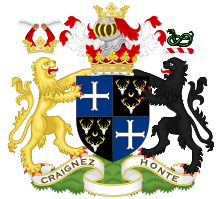William Cavendish-Bentinck, 6th Duke of Portland
DL | |
|---|---|
 The Duke of Portland, circa 1900. | |
| Master of the Horse | |
| In office 9 August 1886 – 11 August 1892 | |
| Monarch | Queen Victoria |
| Prime Minister | The Marquess of Salisbury |
| Preceded by | The Earl of Cork |
| Succeeded by | The Viscount Oxenbridge |
| In office 16 July 1895 – 4 December 1905 | |
| Monarchs | |
| Prime Minister | |
| Preceded by | The Earl of Cork |
| Succeeded by | The Earl of Sefton |
| Personal details | |
| Born | 28 December 1857 Dunkeld, Perthshire, Scotland |
| Died | 26 April 1943 (aged 85) Welbeck Abbey, Nottinghamshire, England |
| Nationality | British |
| Political party | Conservative |
| Spouse | |
| Children |
|

William John Arthur Charles James Cavendish-Bentinck, 6th Duke of Portland,
Background and education
Portland was the son of
He owned 183,000 acres with 101,000 acres in Caithness with 43,000 acres in Nottinghamshire and 35,000 acres in Northumberland.[1]
Public life
Portland initially embarked on a military career and served as a lieutenant in the
He sat on the Conservative benches in the
He was made a Knight Grand Cross of the
The Portlands visited
He was
The Portlands received Archduke Franz Ferdinand of Austria at Welbeck Abbey for a week in 1913 when the heir to the Austro-Hungarian throne visited England. During the stay he took the Archduke shooting on the estate when, according to Portland's memoirs, Men, Women and Things:
"One of the loaders fell down. This caused both barrels of the gun he was carrying to be discharged, the shot passing within a few feet of the archduke and myself. I have often wondered whether the Great War might not have been averted, or at least postponed, had the archduke met his death there and not at Sarajevo the following year."[14]
From 1937 to 1943 he was
Benefaction and legacies
The Duke and Duchess of Portland were custodians and collectors of fine art. They were respectful and generous to the hundreds of staff they employed. One former servant, George Slingsby, who was employed as a footman at Welbeck Abbey before the First World War, wrote that "most of their staff had a job for life, were well cared for in the estate’s own hospital block when they were ill, and at such times nothing was deducted from their wages, at a time when the working classes had no privileges, or indeed any help from the Government."[15]
His probate was sworn in 1943 at £201,516 (equivalent to about £9,600,000 in 2021), with his son as his heir.
Thoroughbred horse racing
Portland inherited the estate and stud farm near Clumber Park in North Nottinghamshire. Among the horses he owned was St. Simon, who won the 1884 Ascot Gold Cup. He also bred and owned Ayrshire and Donovan, who won the 1888 and 1889 runnings of The Derby.
in 1890 Portland built "The Winnings", a row of 6 almshouses at Welbeck Abbey, with the proceeds of his horse racing successes.[16][17]
Family

Portland married
]- Lady Victoria Alexandrina Violet Cavendish-Bentinck (born 27 February 1890, died 8 May 1994), married Captain Michael Erskine-Wemyss and had issue. She was the last surviving godchild of Queen Victoria.[18]
- William Arthur Henry Cavendish-Bentinck, 7th Duke of Portland (born 16 March 1893, died 21 March 1977)
- Lord (Francis) Morven Dallas Cavendish-Bentinck (born 27 July 1900, died 22 August 1950), died unmarried.
Portland died in April 1943, aged 85, and was interred at the traditional burial place of the Dukes of Portland in the churchyard of St Winifred's Church at Holbeck.
He was succeeded by his eldest son, William. The Duchess of Portland died in July 1954, aged 90.[
Ancestry
Arms

|
|
Publications
Portland was author of the following memoirs:
- Fifty Years and More of Sport in Scotland (1933)[19]
- Memories of Racing and Hunting (1935)[19]
- Men, Women and Things (1937)[19]
References
- ^ The great landowners of Great Britain and Ireland
- ^ a b Biography of the 6th Duke, with links to online catalogues, from Manuscripts and Special Collections, The University of Nottingham
- ^ ISBN 2-940085-02-1.
- ^ a b c Kelly's Handbook to the Titled, Landed and Official Classes, 1918. Kelly's. p. 1250.
- ^ Army List.
- ^ "No. 25615". The London Gazette. 10 August 1886. p. 3854.
- ^ "No. 26645". The London Gazette. 19 July 1895. p. 4101.
- ^ "No. 25617". The London Gazette. 17 August 1886. p. 4005.
- ^ "No. 26743". The London Gazette. 26 May 1896. p. 3123.
- ^ "No. 27175". The London Gazette. 20 March 1900. p. 1875.
- ^ "Court Circular". The Times. No. 36092. London. 17 March 1900. p. 8.
- ^ "No. 27330". The London Gazette. 5 July 1901. p. 4469.
- ^ "Court Circular". The Times. No. 36945. London. 8 December 1902. p. 9.
- ^ [1] BBC Radio Nottinghamshire article.
- ^ Nina Slingsby, "George: Memoirs of a Gentleman's Gentleman," Jonathan Cape, 1984: London, 73
- ISBN 9780224099455.
- ^ "THE WINNINGS AND SUNDIAL THE WINNINGS AND SUNDIAL, 1-6, WINNINGS ROAD". Historic England. Retrieved 13 April 2024.
- ^ Massingberd, Hugh, ed. (1995) The Daily Telegraph Book of Obituaries. Macmillan; p. 324
- ^ a b c Who Was Who, 1941-1950. A and C Black. 1952. p. 928.

